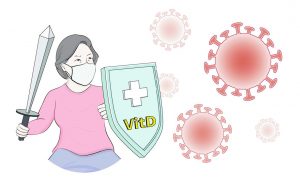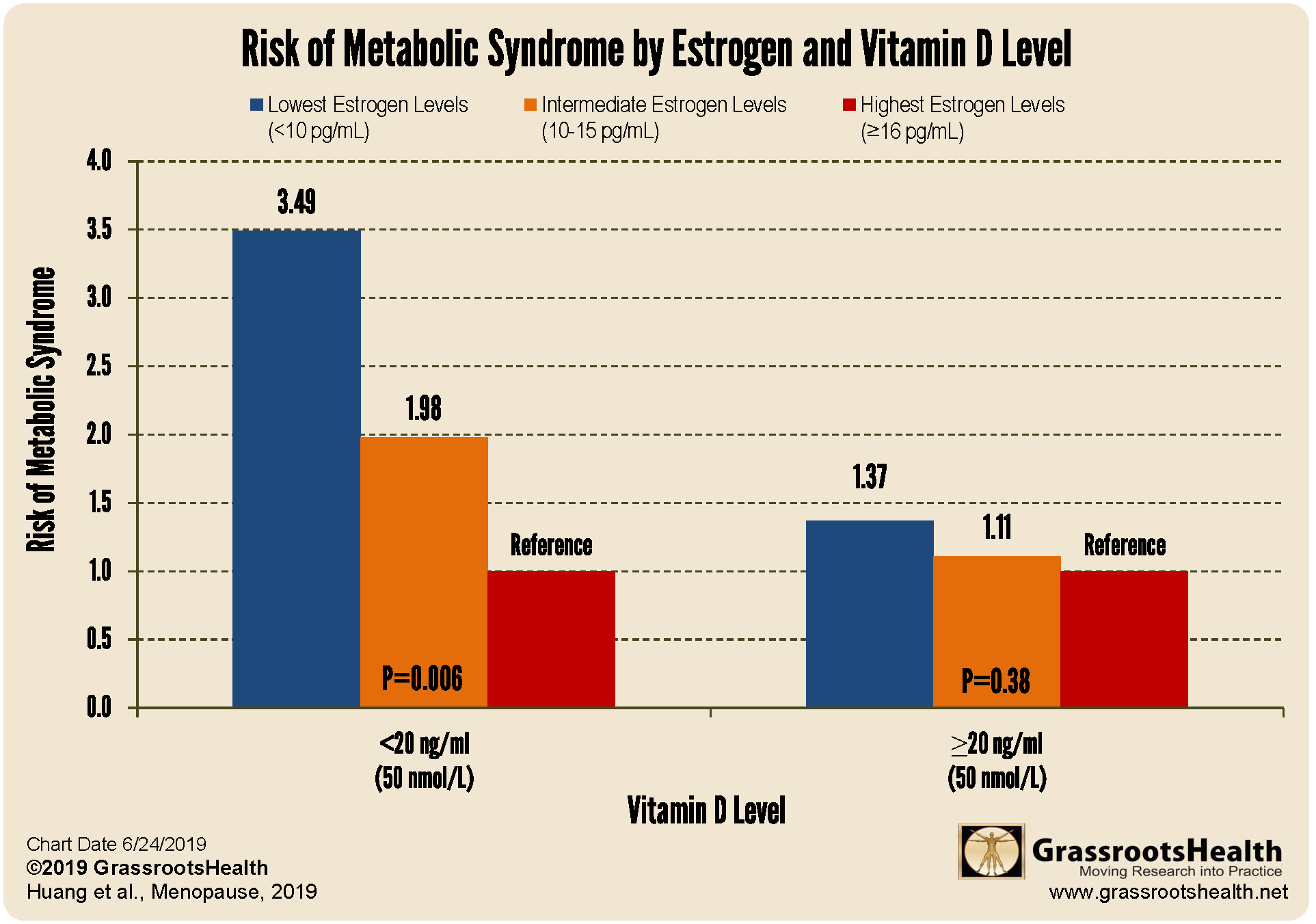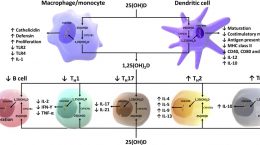Published on January 19, 2022
Menopause triggers changes in the immune response that can affect how women respond to infections and vaccination. Learn how vitamin D may help!
Key Points
- During the post-menopausal period, women can experience an increase in pro-inflammatory chemicals, increased cytokine responses, and decreased activity of certain immune cells
- The risk of certain infections has been observed to be increased among women during post-menopause, including human papillomavirus (HPV) and HIV-1 infections; immune responses to vaccination and vaccine effectiveness are reduced with age, with higher levels of inflammation also contributing to this reduced effectiveness
- Studies suggest a synergistic role between estrogen and vitamin D such that those with low levels of both vitamin D and estrogen were particularly at risk for metabolic syndrome, a pro-inflammatory condition and a well-known risk factor for severe COVID-19 disease
 Aging and estrogen deprivation, both of which occur during menopause, can trigger many physical changes for women, especially changes within the immune system. During the post-menopausal period, women can experience an increase in pro-inflammatory chemicals, increased cytokine responses, and decreased activity of certain immune cells (including T and B lymphocytes and natural killer cells which are necessary to recognize and fight pathogens). It is also during this time that women experience a higher risk for various chronic diseases and health complaints.
Aging and estrogen deprivation, both of which occur during menopause, can trigger many physical changes for women, especially changes within the immune system. During the post-menopausal period, women can experience an increase in pro-inflammatory chemicals, increased cytokine responses, and decreased activity of certain immune cells (including T and B lymphocytes and natural killer cells which are necessary to recognize and fight pathogens). It is also during this time that women experience a higher risk for various chronic diseases and health complaints.
Vitamin D is especially important during this time, not only due to its roles in maintaining healthy bones, but especially for its roles in regulating the immune response, as reviewed in a paper by Min et al. and summarized below.
Immunosenescence: Changes in the Immune System Due to Aging
Not only do women deal with the hormonal changes that come with menopause, they also must adjust to the changes specifically due to aging. Aging itself can cause certain changes in both the innate and adaptive immune system (called immunosenescence) that may lead to a decreased response to pathogens, increased autoimmunity, lower vaccination responses, chronic diseases (including cancer), and increased mortality rates. Specific changes to immune cell function due to aging (for both men and women) will be reviewed in another upcoming post… stay tuned!
Infections and Vaccine Responses among Post-Menopausal Women
The risk of certain infections has been observed to be increased among women during post-menopause, including human papillomavirus (HPV) and HIV-1 infections. One study found that the likelihood of contracting HIV was 4 times greater for women over the age of 45 years compared to younger women, while another study found an almost double rate of mortality from HIV among elderly women compared to elderly men.
It has also been observed that immune responses to vaccination and vaccine effectiveness are reduced with age, with higher levels of inflammation also contributing to this reduced effectiveness – another part to be covered in more detail in our upcoming post on immunosenescence.
Vitamin D, Estrogen, and Pro-inflammatory Conditions in Post-Menopausal Women
A classic example of a chronic, pro-inflammatory condition is metabolic syndrome, a well-known risk factor for severe COVID-19 disease. Metabolic syndrome is a group of risk factors that occur together and increase your risk of heart disease, stroke, and type 2 diabetes. Having at least three of the following risk factors could indicate metabolic syndrome: high blood pressure, high blood sugar, high triglyceride levels, low HDL cholesterol levels, and excess body fat around the waist.
Age and estrogen loss have been strongly associated with metabolic syndrome, as has vitamin D. A 2019 study by Huang et al. assessed the association between vitamin D, estrogen, and metabolic syndrome among 616 post-menopausal women aged 49-86 years, and their findings suggested a synergistic role between estrogen and vitamin D such that those with low levels of both vitamin D and estrogen were particularly at risk for metabolic syndrome.
As can be seen in the chart above, among women with vitamin D levels less than 20 ng/ml (50 nmol/L), those with the lowest estrogen levels had almost 3 ½ times higher risk of metabolic syndrome compared to women with the highest estrogen levels (P=0.006). This association was not seen among women with vitamin D levels at or above 20 ng/ml, which suggests that vitamin D may have a protective effect against metabolic syndrome, especially among post-menopausal women, and that vitamin D may help protect against the additional negative impact of lower estrogen levels.
Maintaining Healthy Vitamin D Levels is Important for ALL, Especially Aging Women
 Having and maintaining healthy vitamin D levels and other nutrient levels can help improve your health now and for your future. Choose which to measure, such as your vitamin D, omega-3s, and essential minerals including magnesium and zinc, by creating your custom home test kit today. Take steps to improve the status of each of these measurements to benefit your overall health. You can also track your own intakes, symptoms and results to see what works best for YOU.
Having and maintaining healthy vitamin D levels and other nutrient levels can help improve your health now and for your future. Choose which to measure, such as your vitamin D, omega-3s, and essential minerals including magnesium and zinc, by creating your custom home test kit today. Take steps to improve the status of each of these measurements to benefit your overall health. You can also track your own intakes, symptoms and results to see what works best for YOU.
Enroll and test your levels today, learn what steps to take to improve your status of vitamin D (see below) and other nutrients and blood markers, and take action! By enrolling in the GrassrootsHealth projects, you are not only contributing valuable information to everyone, you are also gaining knowledge about how you could improve your own health through measuring and tracking your nutrient status, and educating yourself on how to improve it.






